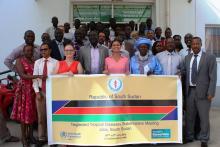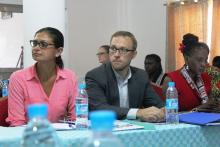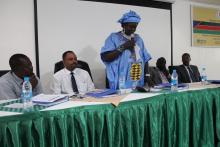South Sudan embarks on drive to eliminate NTDs within five years
Juba, 16 July 2015 -- South Sudan, with support from WHO and health partners, has embarked on a drive to eliminate Neglected Tropical Diseases (NTD) currently affecting the country within the next five years.
NTDs are a diverse group of diseases with distinct characteristics that thrive mainly among the poorest populations. The 17 NTDs prioritized by WHO are endemic in 149 countries and affect more than 1.4 billion people, costing developing economies billions of dollars every year.
Thirteen of the prioritized NTDs are found in South Sudan and include Dracunculiasis (commonly known as Guinea Worm Disease), Trachoma, Leprosy, Buruli Ulcer, Human African Trypanosomiasis, Visceral Leishmaniasis (Kala-azar), Mycetoma, Lymphatic filariasis, Onchocerciasis (River blindness), Soil Transmitted Helminths, Schistosomiasis (Bilharzia), Nodding Syndrome and Loiasis.
“These diseases debilitate, blind or maim and permanently curtail human potential. They also impair childhood growth, intellectual development and educational outcomes. They thrive where there is abject poverty, poor sanitation, sub-optimal living conditions and limited or no access to clean water supply,” says Mr. Evans Liyosi, Focal Point for NTDs at WHO South Sudan, in a speech read on behalf of Dr. Tarande Manzila, WHO Country Representative to South Sudan.
However, there is hope for affected communities.
Evidence shows that controlling NTDs significantly reduces illness, social exclusion and mortality, while prevention and control contribute directly to improved economic productivity. Some of the measures that can be taken include preventive chemotherapy (PC) and mass drug administration (MDA).
Dr. Margaret Itto, State Minister of Health for Eastern Equatoria State also emphasizes the importance of educating communities as a prevention and control measure.
“Most NTDs can be addressed. Community awareness and involvement is key in reducing cases,” Dr. Itto says.
As a starting point, the Ministry of Health, supported by partners, is developing a five year plan for eliminating NTDs over the period 2016 to 2020. To kick start the process was a stakeholders’ workshop that brought together 60 participants comprised of NTD stakeholders as well other non-governmental organisations (NGO) and UN agencies involved in NTDs. The workshop sought to strengthen the capacity of the South Sudanese national NTD programme to develop its Master Plan up to 2020, as well as an annual NTD Plan for 2016. This will guide stakeholders on key activities to be implemented in tackling NTDs and the timelines.
This initiative is in line with efforts that are underway throughout the continent to eliminate NTDs. The World Health Assembly (WHA66) and the AFRO Regional Committee (RC63) recently passed resolutions to accelerate actions for NTD that are amenable to preventive chemotherapy (PC-NTD). These are onchocerciasis, lymphatic filariasis, soil transmitted helminthes, schistosomiasis and trachoma.
Although some interventions against NTDs have been taking place in parts of the country, with support from various partners, they have been splintered. Consequently, the status of NTDs in South Sudan is varied. While great strides have been made in tackling some diseases like Dracunculiasis, information about most of the other NTDs is very limited.
For instance, according to Mr. Makoy Samuel, Coordinator of the NTDs Programme in the Ministry of Health, the country is close to eliminating Dracunculiasis. So far only one case has been confirmed in the first six months of 2015, a major achievement for the country that has moved from 20,581 cases in 2006 to 70 in 2014. The disease is scheduled for elimination in South Sudan at the end of 2015 and partners are confident that this can be achieved.
“We believe we have everything it takes to eradicate Dracunculiasis as we are still on track,” Makoy said.
On the other hand, he says there is very little data on the other diseases. South Sudan is among the countries with the highest prevalence of Trachoma. However, there are major gaps in data, implementation and capacity, which all need to be strengthened.
He further notes that the country has a heavy burden of Onchocerciasis, with about 8 million people at risk of being infected. Although MDAs have been conducted, they have not reached the level where they can make a dent in the number of cases.
Data on Lymphatic filariasis is very limited, with mostly historical data from a few NGOs. Similarly, historical data reflects that Schistosomiasis is common in Unity and Upper Nile states. There is also need to look at co-endemicity of various NTDs, data that is not yet available in South Sudan.
Dr. Itto says all this shows there is need for further research and mapping of the diseases and affected areas in order to ensure a more structured and coordinated response. Of critical importance is the mapping of the outstanding Case Management (CM) NTDs and Preventive Chemotherapy(PC) NTDs in the country, since this is essential for scale up of interventions.
The stakeholders’ workshop and subsequent strategic plan therefore provide an opportunity to improve on available information on the status of the disease and interventions, thereby contributing towards a more coordinated response. This will better guide programme implementation and give stakeholders a clearer indication of resources required to eliminate these diseases.
“The development of an in-country NTD Master Plan document is critical in commencing or scaling up interventions as well as in implementing effective monitoring and evaluative activities for the achievement of elimination of target NTDs by 2020,” Dr. Manzila said.
This is underscored by Dr. Makur Matur Kariom, Under-secretary in the Ministry of Health, who assures partners of Government commitment to support the process of developing and implementing the NTD five-year master plan for South Sudan.
Dr. Manzila commends efforts by the Government and people of South Sudan, as well as efforts by health partners towards controlling and eliminating NTDs despite huge challenges. He pledges WHO’s continued commitment and support in accelerating interventions to control, eradicate and eliminate NTDs in line with the WHA and AFRO RC resolutions of 2013.
This, Dr. Itto says, can be achieved through coordinated efforts.
“If we put our heads and minds together, we can succeed against these diseases and knock NTDs out one by one. It just needs commitment, harmonised efforts and resources,” she says, summing up the general sentiment of health partners.
___________________________________
For more information please contact:
Matilda Moyo
Mobile: +211 955 036 439
Email: whossinfo [at] gmail.com or matilda.moyo [at] gmail.com
Skype: matilda.moyo
___________________________________
Below:
Partners met to craft the Master Plan for eliminating neglected tropical diseases in South Sudan in the next five years
Some of the stakeholders who met to strategise on ways to eliminate neglected tropical diseases in South Sudan
Dr. Margaret Itto, State Minister of Health






